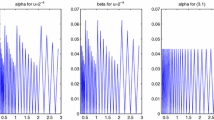Abstract
A model of the relative error in floating point multiplication is developed and is analyzed stochastically for various choices of computer design parameters. These parameters include the base, the type of rounding rule, the number of guard digits, and whether the post-arithmetic normalization shift (if needed) is done before or after rounding. Under the assumption of logarithmic distribution for the fraction (mantissa), the major stochastic conclusions are:
-
1.
The average relative error in multiplication increases as the base increases.
-
2.
This error is minimized by selecting the machine base to be binary (better yet, binary with a hidden bit) and is rather large for machines with base 16.
-
3.
The classical relative error bounds are pessimistic. The average overestimation by those bounds increases as the base increases.
Zusammenfassung
Es wird ein Modell für den relativen Fehler bei der Gleitkomma-Multiplikation entwickelt unf für verschiedene Kombinationen der Arithmetikparameter stochastisch analysiert. Die Parameter sind die Basis, die Rundungsart, die Anzahl der Schutzstellen, und ob die Normalisierung vor oder nach dem Runden erfolgt. Bei einer angenommenen logarithmischen Verteilung für die Mantisse kommt man zu folgenden Schlüssen:
-
1.
Der durchschnittliche relative Fehler bei der Multiplikation wächst mit der Basis.
-
2.
Dieser Fehler wird minimal für die Basis 2 (am besten mit verborgenem ersten Bit) und recht groß für die Basis 16.
-
3.
Die klassischen Schranken für den relativen Fehler sind pessimistisch. Ihre durchschnittliche Überschätzung wächst mit der Basis.
Similar content being viewed by others
References
BFGL [79] Bustoz, J., Feldstein, A., Goodman, R., Linnainmaa, S.: Improved trailing digits estimates applied to optimal computer arithmetic. J. ACM26, 716–730 (1979).
Feldstein and Goodman [76] Feldstein, A., Goodman, R..: Convergence estimates for the distribution of trailing digits. J. ACM23, 287–297 (1976).
Goodman [81] Goodman, R.: Some models of error in floating point multiplication. Computing27, 227–236 (1981).
Goodman and Feldstein [77] Goodman, R., Feldstein, A.: Effect of guard digits and normalization options on floating point multiplication. Computing18, 93–106 (1977).
Henrici [62] Henrici, P.: Discrete Variable Methods in Ordinary Differential Equations. New York: Wiley 1962.
Kaneko and Liu [73] Kaneko, T., Liu, B.: On local roundoff errors in floating-point arithmetic. J. ACM20, 391–398 (1973).
Knuth [69] Knuth, D. E.: The Art of Computer Programming, Vol. 2: Seminumerical Algorithms. Reading, Mass.: Addison-Wesley 1969.
Sterbenz [74] Sterbenz, P. H.: Floating Point Computation. Englewood Cliffs, N. J.: Prentice-Hall 1974.
Tsao [74] Tsao, N.-K.: On the distributions of significant digits and roundoff errors. Comm. ACM17, 269–271 (1974).
Turner [82] Turner, P.: The distribution of leading significant digits. IMA J. of Num. Anal.2, 407–412 (1982).
Author information
Authors and Affiliations
Additional information
Dedicated to Professor R. Albrecht on the occasion of his 60th birthday
Part of the work of R. Goodman was supported by The National Science Foundation under Grants MCS-8004231 and MCS-8301238. Another part of the work of R. Goodman was done while he was in residence at the Applied Mathematics Division of the Argonne National Laboratory, Argonne, IL. The work done by Alan Feldstein was while he received sabbatical leave support from Arizona State University and held a visiting appointment at Brunel University, Uxbridge, U.K.
Rights and permissions
About this article
Cite this article
Goodman, R.H., Feldstein, A. & Bustoz, J. Relative error in floating-point multiplication. Computing 35, 127–139 (1985). https://doi.org/10.1007/BF02260500
Received:
Revised:
Issue Date:
DOI: https://doi.org/10.1007/BF02260500




